
Islamic architecture is the range of architectural styles of buildings associated with Islam. It encompasses both secular and religious styles from the early history of Islam to the present day. Early Islamic architecture was influenced by Roman, Byzantine, Persian, Mesopotamian and all other lands which the Muslims conquered in the 7th and 8th centuries. Further east, it was also influenced by Chinese and Indian architecture as Islam spread to Southeast Asia. Later it developed distinct characteristics in the form of buildings, and the decoration of surfaces with Islamic calligraphy and geometric and interlace patterned ornament. The principal Islamic architectural types for large or public buildings are: the Mosque, the Tomb, the Palace and the Fort. From these four types, the vocabulary of Islamic architecture is derived and used for other buildings such as public baths, fountains and domestic architecture.
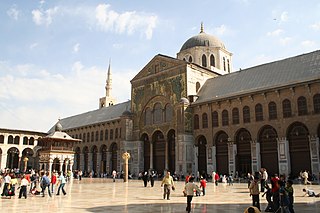
The Umayyad Mosque, also known as the Great Mosque of Damascus, located in the old city of Damascus, is one of the largest and oldest mosques in the world.

The Great Mosque of Muhammad Ali Pasha or Alabaster Mosque is a mosque situated in the Citadel of Cairo in Egypt and commissioned by Muhammad Ali Pasha between 1830 and 1848.
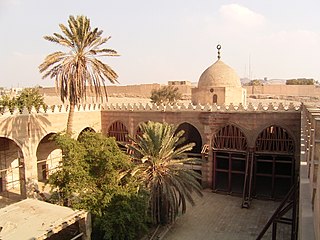
The Aqsunqur Mosque is located in Cairo, Egypt and is one of several "blue mosques" in the world. It is situated in the Tabbana Quarter in Islamic Cairo, between Bab Zuweila and the Citadel of Saladin The Aqsunqur Mosque also serves as a funerary complex, containing the mausoleums of its founder Shams ad-Din Aqsunqur, his sons, a number of children of the Bahri Mamluk sultan an-Nasir Muhammad and that of its principal restorer, Ibrahim Agha al-Mustahfizan.

The Great Mosque of Aleppo or the Umayyad Mosque of Aleppo is the largest and one of the oldest mosques in the city of Aleppo, Syria. It is located in al-Jalloum district of the Ancient City of Aleppo, a World Heritage Site, near the entrance to Al-Madina Souq. The mosque is purportedly home to the remains of Zechariah, the father of John the Baptist, both of whom are revered in Islam and Christianity. It was built in the beginning of the 8th century CE. However, the current building dates back to the 11th through 14th centuries. The minaret was built in 1090, and was destroyed during fighting in the Syrian civil war in April 2013.

The el-Jazzar Mosque, also known as the White Mosque, is located on el-Jazzar Street inside the walls of the old city of Acre, overlooking the eastern Mediterranean Sea, and is named after the Ottoman Bosnian governor Ahmad Pasha el-Jazzar.

The Sinan Pasha Mosque is an early Ottoman-era mosque in Damascus, Syria, located along Suq Sinaniyya Street.

The Khalid ibn al-Walid Mosque is a mosque in Homs, Syria, located in a park along Hama Street in ash-Shuhada Square. Noted for its Ottoman-Turkish architectural style, the mosque is dedicated to Khalid ibn al-Walid, an Arab military commander who led the Muslim conquest of Syria in the 7th century following the decisive Battle of Yarmouk, which put an end to Byzantine rule in Syria. His dome-topped mausoleum is located in a corner of the prayer hall and has served as a pilgrimage center. Two tall minarets with narrow galleries constructed of alternating horizontal rows of white and black stone are situated at the building's northwestern and northeastern comers and reflect the traditional Islamic architecture style of the Levant.

Ulu Cami, is a 16th-century mosque in Adana, Turkey. It forms part of a complex (külliye) that includes a madrasah and a mausoleum (türbe). The buildings are on Kızılay street, next to the Ramazanoğlu Hall.

The Mahmoudiya Mosque is the largest and most significant mosque in Jaffa, now part of the larger city of Tel Aviv. It is composed of a complex of buildings arranged around two large courtyards and a third, smaller, courtyard. The buildings, gates, and courtyards were built at different stages throughout the 18th and 19th centuries while Southern Syria was under Ottoman rule.
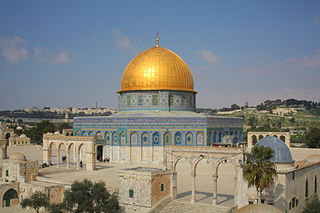
Umayyad architecture developed in the Umayyad Caliphate between 661 and 750, primarily in its heartlands of Syria and Palestine. It drew extensively on the architecture of other Middle Eastern civilizations and that of the Byzantine Empire, but introduced innovations in decoration and new types of building such as mosques with mihrab's and minarets.
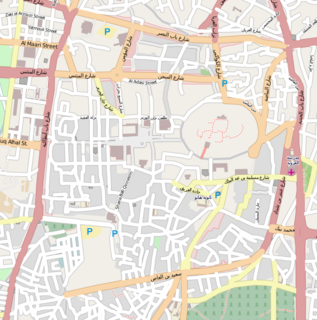
Behramiyah Mosque is one of the historical mosques in Aleppo, Syria, dating back to the Ottoman period. It is located in al-Jalloum district to the west of the Citadel, between gate of Antioch and Khan al-Jumrok, within the historic walls of the Ancient City of Aleppo. The mosque was built in 1583 under the patronage of the Ottoman wali of Aleppo Behram Pasha and during the rule of the Ottoman sultan Murad III. It has an Ottoman khanqah-style architecture with circular minaret and a large central dome.

Emirgan Mosque, officially Emirgan Hamid-i Evvel Mosque is an 18th-century Ottoman mosque located in the Emirgan neighborhood of the Sarıyer district in Istanbul, Turkey.
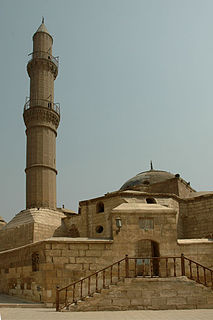
Sulayman Pasha al-Khadem Mosque, also known as Sariat al-Jabal Mosque, is a historical mosque established in 1528 by Suleiman Pasha Al-Khadem, one of the Ottoman rulers of Egypt. It is located inside the Cairo Citadel at the top of Mount Mokattam, and originally erected for the use of the jannisaries stationed in the northern enclosure. It is the first mosque established in Egypt in Ottoman architectural style.
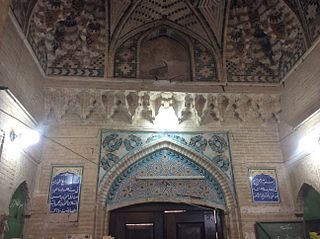
The Al-Wazeer Mosque is an old mosque in Baghdad, Iraq which considered a cultural heritage. The mosque was built by the Wazir of Baghdad Hasan Pasha in 1660 during the Ottoman era. Later the mosque had witnessed several renovation and restoration works. The main characteristic of the mosque is its Ottoman architectural style. It is located in Al-Rusafa neighborhood behind the Souq Al-Sarai, near the riverbank of Tigris. The mosque contains prayer space for more than 400 pilgrims. On the left side of the mosque, there is a round shaped minaret. Within the minaret, there is also a prayer space for more than 250 pilgrims. Attached garden extends to the riverbank of Tigris.

Al-Mahmoudia Mosque is a historic mosque in the city of Cairo. It is located at the Salahuddin Square in the Citadel of Cairo area, in front of Bab al-Azab gate of the citadel. There are Sultan Hassan Mosque and Al-Rifa'i Mosque to the east.
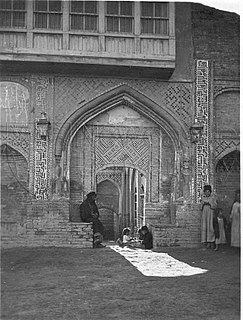
The Said Sultan Ali Mosque is a mosque in Baghdad, Iraq. It is among the cultural heritages of the city, located at the southern part of the historical neighborhood of Rusafa at Al Rasheed Street, near the Al-Ahrar bridge, adjacent to the Tigris. The mosque was first established in 1590, under the rule of Ali Pasha.
Murat Pasha Mosque or Murad Pasha Mosque is the name of some Ottoman mosques. It may refer to:




























